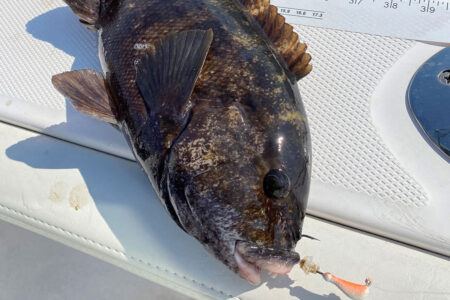A snaky variation of the “tube and worm” rig.
I’ve spent many nights fishing with eels- drifting along structure, edges, bridges and other popular striper haunts, sometimes completely striking out. I found that drifting for stripers when trying to locate fish can be challenging and downright unproductive. Then I learned how to fish the tube and eel.
The tube and eel (T&E) rig can be one of the most productive rigs around as you’re essentially fishing a lure with a chunk of eel that provides scent and helps entice fish to strike. The rig is easy to deploy and can be an alternative to other effective rigs, such as its cousin, the tube and worm.
The T&E is simply a length of thin-to-medium-width surgical tubing ranging from 12 to 24 inches, with a J-hook (see ASMFC 3.2 sidebar) at the end impaled with a chunk of eel; the eel chunk provides scent that helps emulate a live eel. Given the dark color of eels, I prefer to use black surgical tubes; others use the red color used for tube and worm and find it effective.

I freeze my unused eels then cut them into chunks before I fish, putting them in a sandwich bag. Tackle shops often sell their dead eels, usually for less than the cost of live ones, and frozen. Recently while fishing in Niantic, CT, Hillyer’s Tackle provided me with a number of their dead eels that lasted an entire night’s fishing.
When fishing blind (not targeting specific fish on my fishfinder or an actively feeding school), focusing on structure is most productive; piers, bridges, docks and channel edges all consistently produce, with running tides being best. I troll my Old Town Sportsman kayak at 1-1/2 miles per hour, usually in depths up to 15 feet. When depths are greater than 15 feet, adding an egg sinker helps weigh the rig down. T-Man offers a shallow and deep keel system that allows varying weights to be easily added to allow for shallower or deeper presentations.
The tube and eel rig is productive most everywhere; the docks in Delaware’s Lewes-Rehoboth Canal, varied New Jersey sod banks and piers, Jamaica Bay’s edges and rock piles, as well as the reefs along the New England coast are all great candidates for this tactic. The flats can also be productive, I tend to find stripers on the flats during the spring and fall runs.
The tube and eel can also be used in conjunction with the tube and worm. Trolling two rods, one with the tube and worm and the other with the tube and eel, can help diversify the offering, especially if the tube and worm isn’t producing. I try to keep a sandwich bag of cut eel (and a black tube rig) on hand so if the tube and worm action slows (especially as night nears), I change one of my rigs out to a tube and eel.
The tube and eel is most effective when fished at night, as it seems that more striped bass actively feed and come into shallows at night, especially in warmer water temperatures (above 70 degrees). When fishing New England, the bite continues through the day, and the tube and eel will produce accordingly. Daytime boat traffic and sunlight of course tend to put striped bass down, particularly as the sun rises higher in the sky.
The tube and eel can also be quite effective when schools of striped bass are feeding on schools of baitfish where I may not be able to match the hatch with artificials. I recently was fishing Long Island Sound where pods of stripers were feeding on small, inch-long baitfish that I could not emulate with any artificials. I was able to connect by trolling tube and eel rigs on the edge of the schools as one can divert linesiders’ attention with the proven striper candy, the eel imitation.
BIn March, 2021, the Atlantic States Marine Fisheries Commission (ASMFC) officially clarified implementation of the circle hook measures for the recreational fishery as follows – “Circle hooks are required when fishing for striped bass with bait, which is defined as any marine or aquatic organism live or dead, whole or parts thereof. This shall not apply to any artificial lure with bait attached.”
For my rod and reel, I use a 7-foot medium-heavy inshore rod paired with an Ambassadeur 6500 conventional reel. I use two rods and work two rigs provided fishing isn’t too fast and furious. I’m not a fan of fighting double headers, as I can’t enjoy landing a fish if I need to worry about keeping a second fish on the hook while fighting and landing the first one.
When the tube and worm action slows, as night falls or when you can’t match the striper hatch, trolling a tube and eel can land you more stripers, and gives new life to unused eels that would otherwise be thrown out.





